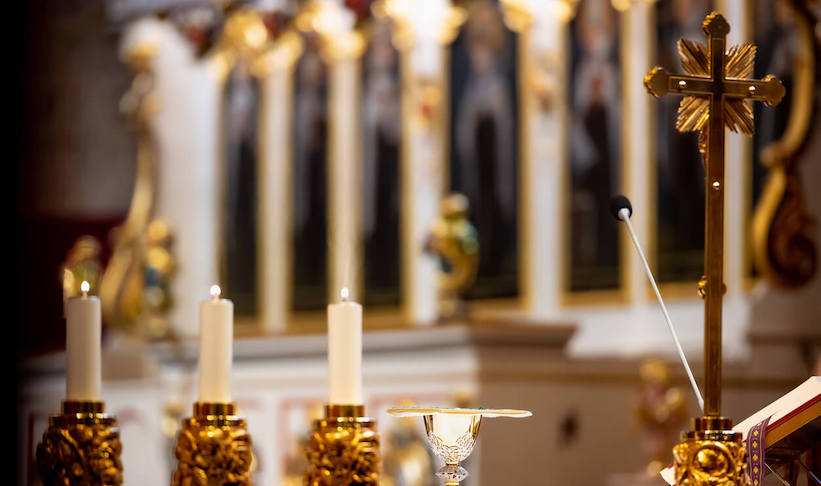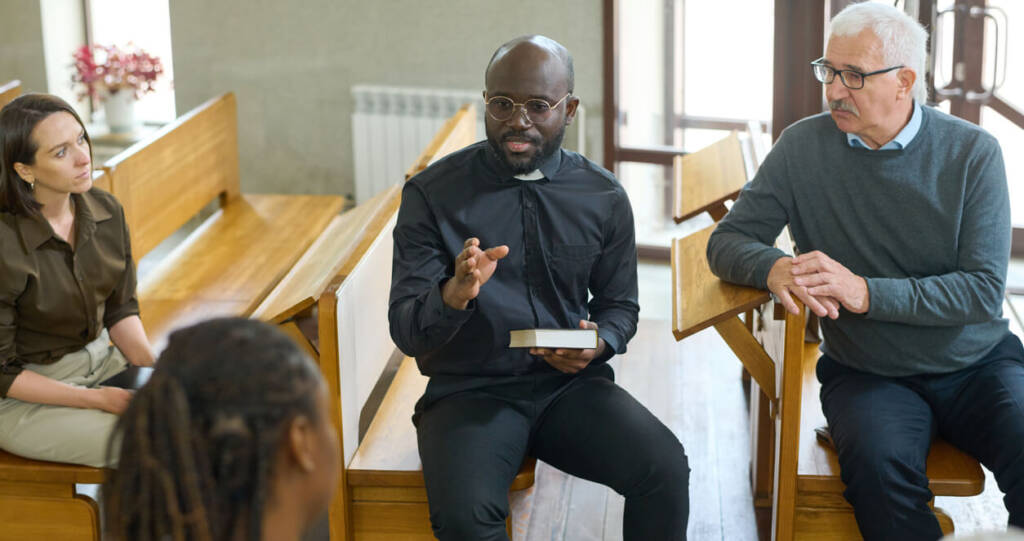You may have encountered minimalism in the context of lifestyle or design: attempting to use or display as few possessions as possible and embracing simplicity as a choice. You may have learned about minimalist philosophy from a documentary, or a blog, or a Pinterest board. In today’s world, “minimalism” has come to refer to an aesthetic rather than a necessity or a result of circumstance.
But the fundamental concept of minimalism is not new — in fact, it’s come to define key aspects of the Catholic tradition, even serving as the foundation for many religious orders. For Catholics in search of a minimalist life, there is much more to learn from the saints than from a magazine or lifestyle blog.
What Is Catholic Minimalism?
In the Catholic faith, minimalism is the intentional embracing of simplicity. This simplicity goes beyond the material — we can espouse simplicity in our words, our actions, and the ways in which we serve others. According to the Sisters of St. Francis in Dubuque, Iowa, simplicity is “an attitude of the heart that urges us to live honestly with a deep gratitude for the gifts, skills, possessions and abilities that we share.”
So what does Catholic minimalism look like in everyday life?
- Owning only what you need to be safe, healthy, and solvent
- Being mindful of not creating waste
- Practicing being close to God through prayer and meditation, rather than through material objects
- Letting go of unnecessary possessions
- Sharing our belongings with others who may have more critical needs
- Trusting that God will provide the things we really need to move through life
Spiritual minimalism isn’t only about letting material things go. It also involves ridding ourselves of guilt, resentment, judgment, envy, fixations, and other unnecessary emotional burdens. When we release things and feelings we don’t need, it clears a path between us and God, and allows us to focus on our relationships between one another and all of creation.
Franciscan Simplicity
People often think of St. Francis of Assisi as the model for intentional poverty and simplicity. Francis abandoned all worldly possessions to spread Christ’s message, closing the earthly distance between himself and his faith. Francis and his followers committed to serving others in return for only what they needed to survive. They shared everything they acquired and gave away any excess. To this day, the Franciscan Brotherhood aspires to practice this same asceticism and generosity.
However, lay people following a Franciscan path (some of whom are Secular Franciscans) live into Franciscan spirituality differently. Having children, pets, and jobs requires that we own things to keep ourselves and each other healthy, safe, and comfortable. But practicing Franciscan simplicity in secular life doesn’t require us to give up our children’s toys or the family car — rather, we can maintain a full life while being thoughtful of how we spend our money, time, and energy, and consider whether every expense is necessary or excessive.
Simplicity and generosity of spirit are at the heart of the Franciscan charism. If we can separate our emotions from our things, we may find that we can be more like St. Francis than we thought possible.
Suggestions for Practicing Minimalism
Minimalism does not require that you give away everything you own. If you are new to Catholic or Franciscan minimalism and want to deepen your commitment, it helps to start, well… simply! Here are some suggestions for practicing minimalism:
- The next time you go shopping for food or clothes, consider which objects are “needs” versus which are “wants.”
- Only buy things for their usefulness, not for the status they imply.
- Set aside time every day to just be — no phone, television, books, or other distractions.
- Practice giving things away, whether in the form of your time, skills, or possessions you no longer need.
- If an item brings you joy, consider whether you are the only one who benefits, or whether the item brings joy to others as well.
- Practice enjoying things without owning them. Borrow books, share music, admire art, and appreciate “shiny objects” from afar.
- Take walks in nature. All the beauty we will ever need is evident in God’s creation.
When you feel as though you have a beginner’s grasp on minimalism, move on to some deeper exercises:
- Take stock of your most prized possessions and consider whether you have infused them with excess meaning.
- Examine your daily routine. Which activities are necessary, and which are habits?
- Consider whether any of your habits resemble an addiction. If so, first rid yourself of any shame around this activity — then work on letting the habit go.
- Practice gratitude for immaterial gifts, such as health, kindness, and acts of service. Be thankful when you receive these gifts, and appreciate when you can share them with others.
- Say only what you need to say. Don’t talk for the sake of talking, don’t share unhelpful opinions, and don’t speak ill of others.
- Be aware of products and practices that oppress or take advantage of others, and do your best to minimize their presence in your life.
If it feels particularly difficult to let go of possessions, think of it this way: We are only stewards of these objects while we are here on earth. We can’t take them with us, as they say, so infusing non-critical objects with a critical purpose won’t affect our eternal happiness. Giving up something of personal value now creates space for spiritual devotion during our lifetime.
When you practice deliberate minimalism, you may find that you experience less discontent, feel less stress, and are more mindful about your words, actions, and choices. With a quieter mind and heart, we can open ourselves up to receiving God’s word in our everyday lives. In doing so, we may find that our relationships deepen, both with one another and with all of the natural world.
Some people find that they want to know more about the origins of spiritual minimalism, and what the saints experienced when they deliberately placed God before material things. An academic opportunity that dives deep into Franciscan theology and the philosophy of asceticism will provide valuable history and insights that carry forward to today.
How to Achieve Minimalism in a Modern World
The world is full of stimuli — noise, emotions, textures, sharp edges. When we have full lives, it can be challenging to minimize contact with these stimuli and create more space for quiet contemplation.
As you begin to pare down your life, reflect on these questions from the Sisters of St. Francis:
- What are my biggest challenges to living the simple life?
- What am I clinging to that is impeding my journey to lead a life of simplicity?
- What gifts have I been given that are waiting to be shared with others?
- What steps have I already taken to living more simply?
- What steps do I still need to take?
Bear in mind that minimizing your possessions does not equate to growing closer to God. Likewise, if you make sacrifices for the wrong reasons — such as pride or attention — it bears no meaning.
On that note, be wary of speakers and authors who promote minimalism through their products or brand. While their ideas may be sound, the act of producing more things for people to acquire goes against the very point of minimalism. As you navigate technologies like the internet and social media, be aware of the true motives of well-meaning influencers. Prioritize media that does not require you to purchase anything.
See overview: University of San Diego – Master of Theological Studies
Gratitude can be the first step toward living a minimalist life. Actively practice gratitude for immaterial things like kindness and empathy. When you consider how much you have without counting your physical possessions, you may realize you are richer than you thought. This is the true meaning of simplicity.
If you find that minimalism or asceticism bring you closer to God, you might consider joining a program or community of like-minded people, or even committing to a consecrated life.
Additional Catholic Minimalism Resources
“Do not store up for yourselves treasures on earth, where moth and decay destroy, and thieves break in and steal. But store up treasures in heaven, where neither moth nor decay destroys, nor thieves break in and steal. For where your treasure is, there also will your heart be.”
Matthew 6:19-21
The best guides to minimalism can be found in Scripture, as well as in the lives of the saints. Besides St. Francis, many other saints practiced sacrifice to clear the way for God’s love. See this slideshow from Aleteia to meet six saints who embraced minimalism.
To learn more about Catholic minimalism in today’s world, check your local library for these titles:
- Not of This World: A Catholic’s Guide to Minimalism by Sterling Jaquith
- Living Like Francis Today by Marci Blum
For discussions on minimalism in the secular world, visit the website of the Franciscan Seculars.
If you seek one-on-one guidance, reach out to your parish priest or a Franciscan order or institution. These teachers and scholars will be able to answer your questions, offer their advice, or recommend further reading. You might also consider an academic program that will delve into the history, theology, and philosophy of Catholic minimalism.




